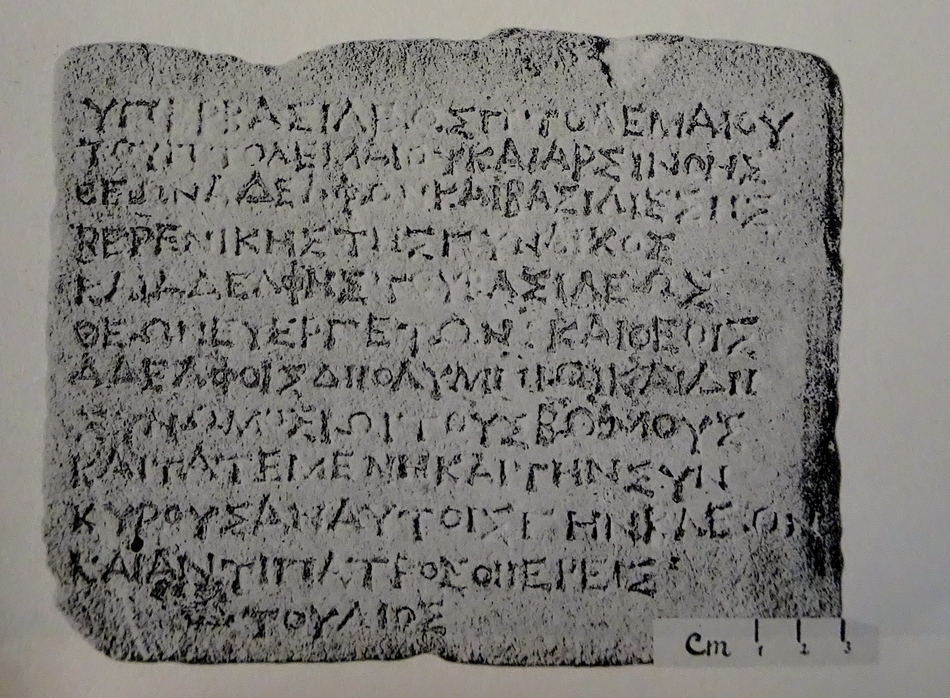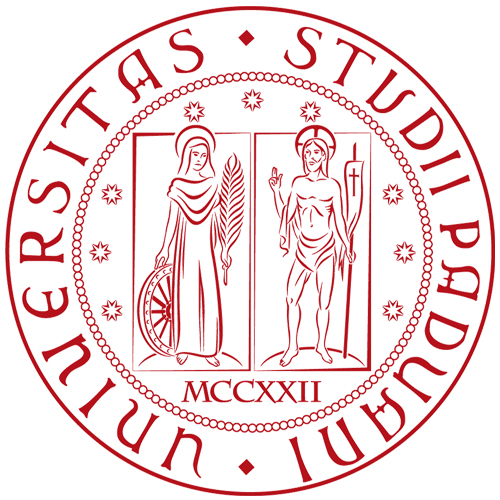
PHRC053 : Dedication to the Theoi Adelphoi, Zeus Olympios and Zeus Synomosios, Alexandria - Egypt (243-211 BC) Dedication
Permanent ID http://s.phrc.it/phrc053
Images
Photo 1: Photo of the stone, from I.Alex.Ptol. Pl. 6, Fig. 14

Text constituted from: Savvopoulos 2020, p. 85 (same as I.Alex.Ptol. 14, but marking the dicolon in line 6).
Other editions: Botti 1894, p. 21-22; Mahaffy 1899, p. 121, n. 1; OGIS 65; SB V 8861 (with add. p. 550); Breccia 1911 (I.Musée d'Alexandrie), no. 10; I.Alex.Ptol. 14; CPI I 15.
See also: Strack 1897, p. 233-234, no. 43); Fraser 1972, I, p. 194; II, p. 326, n. 18, and p. 416, n. 594; McKenzie 2007, p. 52; Fragaki 2011, p. 44; Baralay 2020, 116-119; Savvopoulos 2020, 84-85.
Images: I.Alex.Ptol. Pl. 6, photo 14 (with colour still visible); CPI I, p. 60.
Further bibliography: on dynastic continuity expressed through dedications, Caneva 2016a, p. 180-181, 195-197, and Caneva - Bricault 2019; on the cult of Zeus in Alexandria, see now Dechevez 2021.
Ὑπὲρ
βασιλέως
Πτολεμαίου
τοῦ Πτολεμαίου
καὶ Ἀρσινόης,
Θεῶν
Ἀδελφῶν,
καὶ βασιλίσσης
Βερενίκης
τῆς γυναικὸς
5
καὶ ἀδελφῆς τοῦ βασιλέως,
Θεῶν Εὐεργετῶν :
{καὶ} Θεοῖς
Ἀδελφοῖς
<καὶ> Διὶ
Ὀλυμπίωι
καὶ Διὶ
Συνωμοσίωι
τοὺς βωμοὺς
καὶ τὰ τεμένη
καὶ τὴν συν
-
10
κύρουσαν αὐτοῖς γὴν
Κλέων
καὶ Ἀντίπατρος
οἱ ἰερεῖς
vac. τοῦ Διός. vac.
This dedication was made by two priests of Zeus (perhaps one for each denomination by which the deity is evoked in the text) during the reign of Ptolemy III and Berenike II, the Theoi Euergetai. The presence of the couple’s epithet points to a date after 243/2 BC (see commentary to PHRC 011). The two priests dedicated at least two altars and precincts to the couple of deceased and deified royal ancestors, the Theoi Adelphoi, and to Zeus with the dual denomination Olympios and Synomosios. The mention of the land pertaining to these precincts reveals that this was a major dedication, by which two members of the Alexandrian elite wished to advertise their status and their loyalty to the royal house at a scale exceeding more common dedications of altars or statues (on 3rd-cent. personal initiatives in the dedication of shrines in the Ptolemaic kingdom, cf. Pfeiffer 2008). On the other hand, the silence about possible buildings being erected within the precincts warns us against assuming that Kleon and Antipatros’ dedication also comprised the building of a temple. More plausibly, the donors consecrated a plot of land (of their own property) and divided it into two or more open-air precincts hosting altars for offerings (open-air precincts of ruler cults were rarely provided with major buildings; see commentary to PHRC 003; Caneva 2020d, 236-237).
The inscription clearly delivers a message of dynastic continuity thanks to the dual reference to the Theoi Adelphoi as the royal parents of Ptolemy III and as the co-recipients of the dedication, which is made on behalf of/for the wellbeing of the living couple of the Theoi Euergetai. Similar dedicatory solutions are well attested during the reign of Ptolemy III (cf. I.Hermoupolis 1, where the two royal couples are co-recipients of the dedication of a temple, in the dative) and testify to the donors’ intentions to display their allegiance by adapting to the formulae and ideological messages promoted by the court (Caneva 2016a, 180-181, 196-197; Caneva – Bricault 2019). In our case, the priests of Zeus adopted yet another way to stress their loyalty to the dynasty by granting the Theoi Adelphoi the first place in the dedication, before the two denominations of Zeus.
The text does not allow us to understand how the consecrated spaces and structures were organised and assigned to the Theoi Adelphoi and Zeus respectively. Perhaps the couple of the deified royal ancestors shared one sacred precinct with Zeus Olympios and one with Zeus Synomosios; alternatively, we may assume that a precinct of the Theoi Adelphoi was dedicated next to one (or two) belonging to Zeus with his dual denomination. Be that as it may, the inscription testifies that ritual agents could use spatial proximity in order to express an ideal association between divine and human recipients of cult. An interesting parallel is provided by a decree of the city of Aigai in Aiolis stipulating that a new sanctuary of Seleukos I and Antiochos I be erected next to the existing precinct of Apollo ( CGRN 137, lines 5-7; 281 BC). Spatial proximity thus provides a permanent way of establishing a link between ritually honoured rules and deities, even in cases where no reference to joint offerings can be identified in the text (joint offerings might occur, but they cannot be inferred from spatial proximity). From this perspective, the assumption that the Theoi Adelphoi did not share with Zeus the status of recipients of the dedication (CPI I, p. 59-61) is unconvincing and relies on an unwarranted distinction between the meaning of the datives referring to the royal couple and to the god. As a matter of fact, these cannot but indicate the recipients of the dedication, whereas the living couple of the Theoi Euergetai is evoked with the ‘hyper + the genitive’ formula, which identifies them as the party benefiting from the initiative of the priests.
The joint dedication and the spatial encounter between royal and divine power is paralleled by the selection of the epicleses characterizing Zeus in our text (on Zeus in Alexandria, Dechevez 2021 with the previous refs). The common epithet Olympios points to Zeus as the king of the gods, thus establishing a close link with the supremacy of Ptolemaic kings on earth (see Theocr. 17.16-18 on Zeus being described as the father of Ptolemy I, to whom he conceded honours equal to those of the gods and a gold throne on the Olympos; cf. also Call., Hymn 1, with Brumbaugh 2019). Conversely, Synomosios is a hapax, but its meaning is clear: Zeus is referred to as the patron of oaths, just as in cases where he bears the epithet Horkios (CPI I, p. 61). Zeus and Hera, followed by Poseidon, appeared in the Alexandrian civic oath mentioned in P.Hal. 1, lines 214-218 (mid-3rd cent.). In the same period, the Ptolemaic royal oath was sworn on the names of the ruling couple (Ptolemy III and Berenike II), often followed by the Theoi Adelphoi or by the full dynastic line (Theoi Adelphoi and Theoi Soteres; for a list of the evidence with the various formulae, Caneva 2016a, 225-231). The two donors evidently wished to stress the converging prerogatives of Zeus and of the royal house with regard to legitimate kingship and as sources of legal authority and social order.



